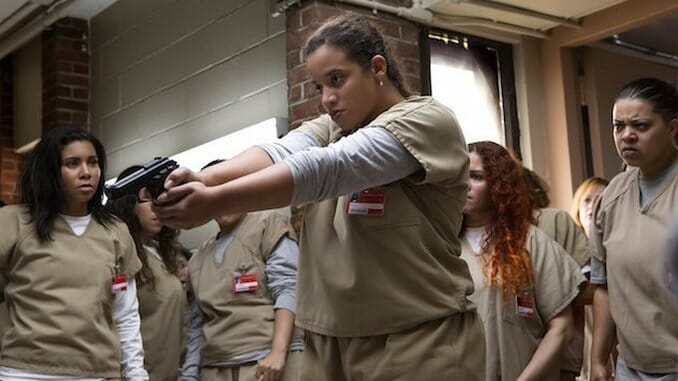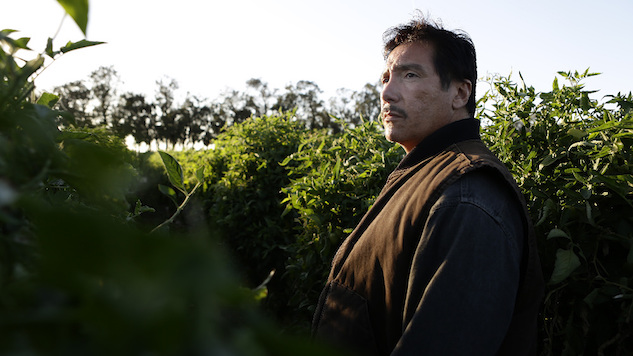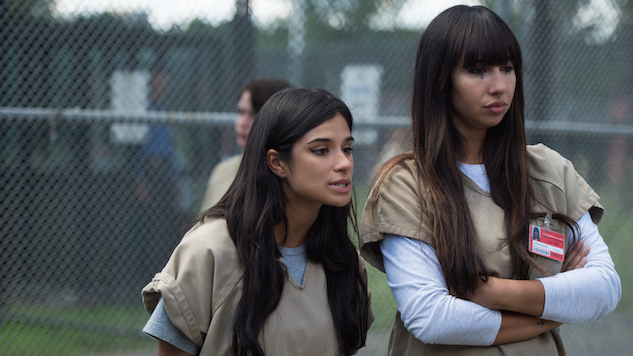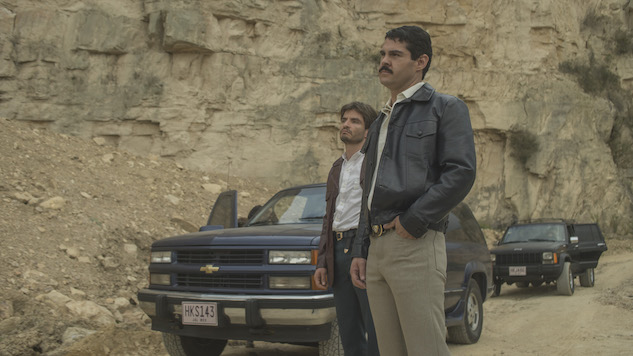The (Un)Changing Face of Latinos on TV
Orange Is the New Black photos: Netflix / American Crime photos: ABC / El Chapo photo: Univision TV Features Representation
Note: This piece appears in Paste Quarterly #2, which you can purchase here, along with its accompanying vinyl Paste sampler.
Growing up in Albuquerque, New Mexico in the late 1970s, the actor Benito Martinez—perhaps best known for his role as The Shield’s ambitious precinct captain and city councilman, David Aceveda—had no sense of the limits placed on Latino performers. Through his mother, Margarita, the co-founder of the bilingual La Compañia de Teatro de Alburquerque (”’La Compañia,’ as we called it”), and the company’s Royal Academy-trained director, José Rodríguez, Martinez saw Latinos in plays by Molière, Shakespeare, Ibsen and Federico García Lorca. Even on TV, more prone to stereotype, he remembers actors brought up on the stage: Re-runs of NBC’s Western High Chaparral featured Puerto Rican Henry Darrow (born Enrique Delgado) as Manolito, a Mexican farmhand, while the network’s popular sitcom, Chico and the Man, starred Puerto Rican-Hungarian Freddie Prinze.
“I had all these images of elegance and range and style, so when I, naively, was trying to build my career, those were my examples,” the soft-spoken Martinez says. “But what I was getting in the ‘80s as a young Latino actor was, ‘You’re going to be a gang member and you’re going to go in and rob the bank.’ I had to then learn about pigeonholing. I had to learn the power of no.”
When I reach Martinez by phone in late March, in the midst of Season Three of ABC’s anthology series American Crime—in which he plays Luis Salazar, a migrant laborer on a North Carolina tomato farm—he is thoughtful and unfailingly gracious: He pays his respects to everyone from Edward James Olmos (“not afraid to play in all the biggest areas”) and Jimmy Smits (“swagger beyond compare”) to Rita Moreno (“committed and brilliant”) and Anthony Quinn (“my favorite of all time”). Despite his appreciation for his fellow actors, though, and for his richly drawn character on American Crime, Martinez suggests that the arc of Latino representation in American popular culture is not one of consistent progress.
“I think we were ahead of the curve many, many years ago,” he says. “We took a great big dip, and we’re back in television—not yet in the movies—in a big way.”
In this, Martinez is more sanguine than the rising generation of Latino performers and screenwriters, not to mention academic experts and advocacy groups. In conversations with on-screen and behind-the-scenes talent from two landmark programs for Latino representation, American Crime and Netflix’s Orange Is the New Black, as in reports compiled by the National Latino Media Council (NLMC) and researchers at the University of Southern California (USC) and the University of California Los Angeles (UCLA), the picture is one of halting transformation, if not stagnation. To hear the frustration of those going out for auditions, scraping together money for short films, or shopping pilots to the broadcast networks is to remember that the series changing the face of Latinos on TV—including Netflix’s One Day at a Time, NBC’s Superstore, and The CW’s Jane the Virgin, among others—remain the exception, not the rule.
“This is an industry that is supposed to be progressive, and I say to you that it is one of the least progressive industries around,” says National Hispanic Media Coalition (NHMC) president and CEO Alex Nogales, echoing Martinez’s memory of moving to Hollywood in the 1980s. “I see now that I was being naive in terms of thinking that the cultural barriers would come down. Being nice is not going to get it done.”

Diane Guerrero, Orange Is the New Black’s more-clever-than-she-lets-on con woman, Maritza Ramos, can still recount the description she once heard of the three stages in Hollywood for an actor of color: playing a two-dimensional character; playing a multi-dimensional character in which race or ethnicity is his or her defining feature; and playing a multi-dimensional character that can’t be glossed, as Guerrero puts it, with ”’This is Sally, she’s Puerto Rican,’ or ‘This is Brian, he’s Mexican American.’” But for Guerrero and cast mates Jackie Cruz and Dascha Polanco, the success of creator Jenji Kohan’s prison-set series, whose fifth season debuted earlier this month, has not generated more opportunities at the second or third stages, a sentiment repeated by Martinez’s American Crime co-star, Richard Cabral. Gang members, gardeners, girlfriends and maids continue to comprise the lion’s share of roles offered to the quartet—to the point that each has had to learn, as Martinez did three decades ago, “the power of no.”
“I don’t want to play the lead because I’m Dominican,” Polanco says, praising director David O. Russell for casting her as Jennifer Lawrence’s best friend, and not “the Spanish girl,” in his 2015 film, Joy. “I want to play a role like in Game of Thrones. I want to play with dragons. I want to play in Marvel. I want to play a superhero.”
Though the number of TV series to feature multiple Latinos in key roles is on the rise—Jane the Virgin and One Day at a Time depict Venezuelan American and Cuban Americans families in Miami, respectively; Hulu’s East Los High, with its all-Latino cast and crew, follows a group of students in East Los Angeles; and Netflix features a number of bilingual and Spanish-language series, including Narcos and Ingobernable—the performers I spoke with lamented the persistence of the “one Latino/a” problem: In the main, films and TV series feature no more than a single Latino character, if that. As a result, the number and range of roles has not kept pace with the growing pool of talented Latino actors.
“I’m not kidding you when I tell you that I’ll go for stereotypical roles, and I’ll literally see everyone from my cast there,” Cruz says. “It is changing, but very slowly. It’s taken me 15 years to get a role like this.”
Camila Jimenez Villa, co-president and chief creative officer of Fusion Media Group (FMG), a division of Univision Communications Inc. (UCI), suggests that TV networks’ and film studios’ commitment to diversity and inclusion, and to programs designed to bring emerging Latino artists into the Hollywood fold, often appears pro forma.
“This cannot be, ‘Let me check the box, let me make sure I have that represented so when Matt calls me, I can point to one or two examples,’” Villa says. “The numbers are just so underwhelming compared to what would be fair representation given the Latino population in the United States.”
The statistics are damning: In its most recent assessment of inclusion in film and TV, released in 2016, the Media, Diversity & Social Change (MDSC) Initiative at USC’s Annenberg School for Communication and Journalism found that only 5.8% percent of speaking or named characters were Hispanic/Latino, versus 17% of the total U.S. population; across broadcast, cable and streaming outlets, just 12.6% of directors came from all underrepresented racial/ethnic groups combined, versus 37.9% of the population. The rate of change has been disappointing, too: In an analysis of television from the 2012-2013 season, the Ralph J. Bunche Center for African-American Studies at UCLA reported that Latinos made up 2-3% of broadcast and cable roles, indicating that the road to TV “representative of the reality that we live,” as Villa says, remains a long one.
In truth, it already has been. In the fall of 1999, after the four broadcast networks (ABC, CBS, NBC, and FOX) failed to cast a single black, Latino or Asian lead in any of their 26 new series, an alliance of organizations known as the Multi-Ethnic Media Coalition responded with such vociferous criticism that the networks signed Memoranda of Understanding promising to hire more minorities in front of and behind the camera—and to furnish data on inclusion to signatories such as the NAACP and the NLMC. Though the Memoranda preclude Nogales from revealing the latest statistics in absolute terms, it’s clear from our conversation that he’s furious.
“The numbers are going back, they’re not going forward,” he says, noting that growth for Latinos in the areas the NLMC grades—scripted and unscripted actors, writers, producers, directors, and executives at the “Big Four” networks—began to plateau seven or eight years after the Memoranda came into effect in 2000-2001. “How the hell do you do that? They did it… They’re not doing a goddamn thing for us.”
Though her tone is more circumspect, Guerrero knows firsthand that the traditional networks continue to lag behind their cable and streaming counterparts in terms of Latino representation. Formerly in development at CBS for the 2017-2018 season, a TV series based on her memoir, In the Country We Love—in which Guerrero recounts her undocumented parents’ deportation to Colombia when she was just 14—is “tied up at the moment,” though she promises she won’t stop at that.
“We can’t wait for them to choose us,” she says. “We have to work there ourselves.”

After her family came to the U.S. from Lima, Peru, American Crime writer Janine Salinas Schoenberg remembers her parents’ long working hours, when she and her sister searched the airwaves for characters whose experiences resembled their own. That there were so few—Schoenberg, of Iranian and Peruvian descent, cites Wilson Cruz’s “racially ambiguous” Rickie Vasquez, on ABC’s teen drama My So-Called Life—lends her description of TV an unexpected pathos, suggesting a medium as revealing for what it doesn’t show as for what it does: “TV was my crash course in all things America.”
It wasn’t until 2006, more than a decade after the cancellation of My So-Called Life, that ABC debuted the series Schoenberg says inspired her, a groundbreaking portrait of an intelligent, ambitious Latina that focused on both her career and her kin: Ugly Betty, starring America Ferrera, which Cuban American Silvio Horta developed from the Colombian telenovela Yo soy Betty, la fea. As Schoenberg points out, the series’ depiction of a Latino family remains more or less sui generis, at least for the “Big Four” broadcast networks. Since the end of Ugly Betty in 2010, the foremost example may be ABC’s one-season sitcom Cristela, which creator and star Cristela Alonzo, in a blog post written upon the series’ cancellation, accused the network of mishandling: “It was a multi-cam sitcom that SOMETIMES aired on Friday nights. I say sometimes because a lot of times we were pre-empted for more important things like an Easter egg hunt happening in real time.”
It’s the start-and-stop nature of progress for Latinos on TV, its “two steps forward, one step back” aspect, that underscores, and perhaps encourages, Hollywood’s lead-footedness on the issue. When successes are framed as flukes, and failures as proof that audiences are uninterested in Latino stories, the real work at hand—elevating Latinos to positions of leadership in both boardrooms and writers’ rooms—becomes far more difficult.
“I just don’t buy that argument,” Villa says when I bring up the persistent claim that networks are merely protecting the bottom line. “I don’t buy it because of the numbers, and also because of what we’ve seen with the response to shows like Narcos and Orange Is the New Black. Anybody under the age of 30, almost 50% of those people are not white,” she adds. “I don’t know how you can talk about a niche market anymore. I think it’s just the new shape and color of this country.”
Villa, who also oversees FMG’s Story House Entertainment, which develops and produces content for Univision-owned networks as well as third parties, is adamant that genuine commitment to fair representation for Latinos requires finding, cultivating, and nurturing future Latino directors, showrunners and executives—in particular because of the structural barriers that limit minority access to the film schools, internships, entry-level jobs, and networking opportunities that are Hollywood’s social currency. To wit, Story House’s latest series, El Chapo, which chronicles the rise and fall of Joaquín “El Chapo” Guzmán, is helmed by Silvana Aguirre Zegarra, a first-time showrunner from Peru. (El Chapo premiered on Univision in April, with new episodes set to air this fall.) Villa describes the prevailing reluctance to expend time and resources on developing talent as a “self-fulfilling prophecy.”
“I don’t think you can change it unless you change the top, because it’s a cascading effect,” she says. “It is true, the pool of talent is smaller, but you can still find it. You have to work a little harder, and you have to be willing to surround the talent with a little bit more support, but I think it’s doable.”
The statistics compiled by the MDSC Initiative appear to confirm Villa’s impression that inclusion “trickles down”: Across film and TV, the number of characters from underrepresented groups increased 17.5% when the director was from an underrepresented group. Anecdotally, at least, this is true for writers, too. Schoenberg’s American Crime colleague, Moises Zamora, describes a meeting with Lost and The Leftovers creator Damon Lindelof in which the TV veteran explained the value of squaring space for an array of perspectives.
“He was really looking out for diverse talent, not because it’s the thing to do, but because different points of view in the room contribute to the overall quality of the project,” Zamora remembers, suggesting that the resulting friction is often fruitful. “It might be a little harder, it might take a little longer, to come to an agreement, because everyone has something to say, but it really adds layers to the storytelling.”
As Nogales notes, however, it often falls to consumers and advocacy groups to pressure networks and film studios to change; despite the Memoranda of Understanding and other, more recent gestures at inclusion, media conglomerates— and, by extension, the cultural artifacts they produce—remain predominantly white and male.
“It isn’t like all these guys are racist,” Nogales says, bristling at the complacency of networks, studios and talent agencies. “They’re just cultural bigots. They don’t understand a group and they don’t put their mind to [doing so]. They don’t make acquaintances or friends with people from that group, because they go by the numbers and they don’t want to explore new worlds. And as a consequence, they’re leaving people out. They’re like Trump.” “These guys gotta get off their asses,” he adds, “or they shouldn’t have a job.”
Inspired by #OscarsSoWhite, created by Washington, D.C.-based writer and editor April Reign in 2015 to “push the dialogue” about minority representation in media after that year’s lily white Oscar nominations, Nogales tells me that NHMC is planning a social media campaign to draw attention to the broadcast networks’ ongoing failure to represent Latinos in adequate numbers. (“We’re going to shame them,” he says.) Though he declines to comment on the details, Nogales confirms that the coalition has made an additional social media hire in preparation, and adds that the group is considering other forms of action, including boycotts and protests.
“This year you’re going to see a lot of demonstrations, a lot of actions, against one of the networks,” he says, though he won’t identify which network will be targeted. “I can’t tell you that, because I want them all to squirm.”
The hope, of course, is that Hollywood will have no choice but to change when faced with viewers voting with their remotes, and thereby their wallets: Latinos in the U.S. consume at a rate of $1.5 trillion a year, according to Nogales, an economic footprint that should be hard to ignore. Public pressure, and the negative press it generates, can be effective. “No studio or network wants to encounter a back-lash like that,” Villa says of the Scarlett Johansson vehicle Ghost in the Shell, which flopped at the box office after sustained criticism for whitewashing its source material. Nonetheless, as Reign herself told The Verge earlier this year, representation remains the goal, not a fait accompli. Despite the success of black performers and their respective films and TV series at both the Oscars and the Emmys—Moonlight and one of its stars, Mahershala Ali; Fences’ Viola Davis; American Crime’s Regina King; and American Crime Story: The People v. O.J. Simpson and two of its stars, Courtney B. Vance and Sterling K. Brown—Latinos, Asians and others continue to be as underrepresented by Hollywood’s most prestigious awards as they are in film and television in general.
In the meantime, faced with the frustrating truth that the transformation of Hollywood is still in the future, Latino artists are taking matters into their own hands: Last year, Cabral staged an autobiographical one-man show, Fighting Shadows, to “feed his soul”; Cruz created her own production company, Unspoken Film, and produced a short called The Bumblebees. As Polanco suggests, white actors with Emmy nominations (à la Cabral) or roles on popular TV programs (à la herself, Cruz and Guerrero) can, in the main, expect new opportunities to follow; for Latinos, by contrast, the fight for representation is constant, and sometimes crushing.
“I’m still proving myself,” Polanco says, remembering the well-wishers that promised her life would change after working with Russell on Joy. “I’m still out there every day. I have to work. I have to hustle… I call my team and I tell them, ‘I’m just so frustrated, I’m so disappointed, and this is something I really love.’ Why does it have to take me to create my own work, and not others?”

Raised in California’s Central Valley, birthplace of the modern agricultural labor movement, Zamora first encountered the plight of mi-grant farmworkers through the stories his father told, stories of toil and exploitation that American pop culture prefers to ignore. Despite this early exposure to the subject, however, Zamora says that the research guiding the third season of American Crime, including interviews, in-depth readings and consultations with the administrators of a human trafficking hotline, reshaped his understanding of “the human cost” embedded in the luxury of inexpensive, year-round produce.
“It’s really impossible not to feel empathy or compassion,” he says of the resulting narrative, which movingly attends to the complex arrangements of race, class and power that enable what Zamora calls “modern slavery.” “It’s heartbreaking.”
The feat of American Crime is, in short, one of representation: It renders the invisible visible, drawing us into its world through our engagement with Martinez’s Luis Salazar and Cabral’s Isaac Castillo—the former in search of his missing son, the latter increasingly troubled by the farm’s malign neglect of its workers. Both are men in full, multilayered and specific. In other words, they’re no longer anonymous.
“If you went to Home Depot today and bought some lumber, you wouldn’t think twice” about the day laborers awaiting work, Martinez says. By contrast, he adds, American Crime, in pausing to consider the histories, ambitions and limitations of characters in similar circumstances, forces us to ask ourselves, “I wonder who those guys are? I wonder where they’re from? I wonder how they got here?”
Orange Is the New Black, set in a women’s prison in upstate New York, poses much the same questions, often explicitly: The series’ defining feature may be its depiction of the characters’ lives before their incarceration, and its empathic understanding that modes of policing and punishment are too blunt for the complexities of social constraints and individual choices.
“It presents you with a stereotype, and then you really see who this person is through the flashbacks, and through the passage of time,” Guerrero says. “It’s easier for people to say, ‘Oh, these are real folks, too.’”
Though the emphasis is on crafting absorbing narratives and vivid characters, the repeated references to Trump, anti-immigrant sentiment and the fraught political climate I hear in the course of my reporting suggest the consequence of inadequate representation, which is the frequent erasure of Latinos from the American imagination. Throughout the campaign, the transition, the new administration’s first 100 days, for instance, the effort to understand the white working-class, or for that matter white liberals, far outstripped attempts to understand, or even to listen to, working-class people of color, undocumented immigrants, Muslim Americans and others poised to suffer the most harm should the White House implement its agenda. The privilege of representation—for white Americans, for men, for straight people—is not only to see oneself in TV’s wholesome families and courageous heroes, but also to be seen by others, and thereby to claim a place in the public square. In “this divisive moment,” as Schoenberg calls it, representation is a form of politics, an act of resistance, an agent of change.
“The hope is that, instead of viewing people as the Other because you don’t know anything about the world that they live in or the circumstances of their everyday life, you’ll learn about what they’re going through,” she says. “The hope is to create a society that is more tolerant and accepting.”

When he began his acting career in his mid-twenties, fresh from a stint in prison and tattooed across his arms, chest and neck, Cabral remembers being relieved to find work, even if it meant playing “Gang Member #1” or “Gang Member #3.” Since then, though, in NBC’s Southland, American Crime, and FX’s forthcoming Sons of Anarchy spinoff, Mayans MC, Cabral has sought roles that stretch him as an artist—and has, to his disappointment, often come up empty-handed.
“It’s rare to come across those scripts,” he says. “That’s why me and my representation have shot down a lot of projects… A lot of people, they see me, and they think what sells is that gangster. I could do those parts with my eyes closed.”
Though Cabral is tenacious—staging the aforementioned Fighting Shadows, using makeup to cover his tattoos in order to expand the pool of potential roles—the extent to which his experience in the present echoes Martinez’s in the 1980s is dispiriting. The reasons cited to me for the intractable nature of the problem are legion, from the TV networks’ and film studios’ aversion to risk and the unbearable whiteness of their boardrooms to the lack of opportunities for emerging talent and casting directors’ continued preference for certain “types,” particularly when it comes to women. But the fact remains that, for all the attention paid to “diversity” and “inclusion” in popular culture, all the well-deserved praise heaped upon films and TV series that accurately reflect the composition of the American public, the needle has scarcely moved.
This is not to undersell the importance of the exceptions to the rule, nor to deny—as everyone I interviewed for this story noted without hesitation—that TV has surged ahead of film in terms of Latino representation. Indeed, what American Crime, Orange Is the New Black, One Day at a Time, Jane the Virgin, Superstore, East Los High and other series past and present offer is ongoing, indisputable proof of concept, showing that stories of the Latino experience can attract audiences and critics, that the emphasis on creating nuanced representations in more significant numbers is not a call for “political correctness,” but an acknowledgement that showing us to ourselves is one of the fundamental promises of popular art.
This is, perhaps, the reason for the particular combination of dissatisfaction and determination I hear in interview after interview. The representation of Latinos on TV has already undergone more than one major transformation since the days of Henry Darrow and Freddie Prinze, a long and winding history constantly crossing paths with the nation’s own, and yet the subject is too often a topic of conversation, rather than a catalyst for real change. Whether the present is the leading edge of a looming revolution or simply another incremental step forward, however, it’s clear that the time for dialogue without action has passed.
“I’m tired of talking about it,” Cruz says as our interview comes to an end. “Now, I want to do it.”
Matt Brennan is the TV editor of Paste Magazine. He tweets about what he’s watching @thefilmgoer.